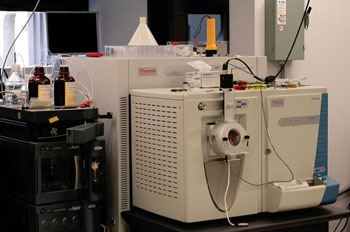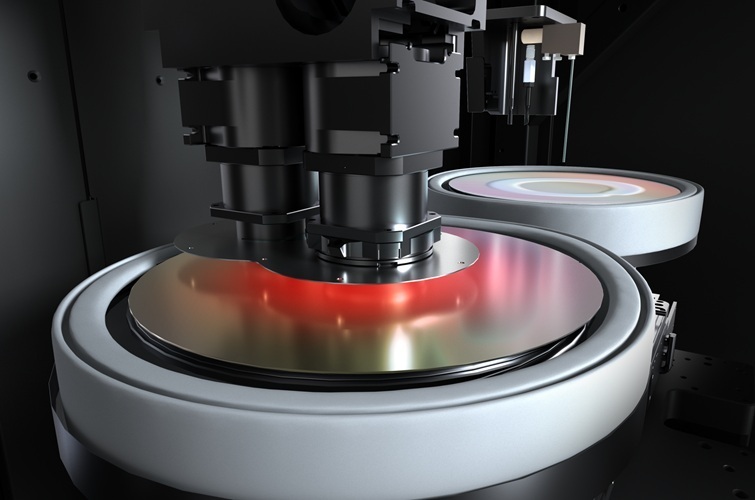Proteome-Based Marker Classifies Chronic Kidney Disease Progression
|
By LabMedica International staff writers Posted on 26 Jul 2016 |

Image: Capillary electrophoresis–mass spectrometry apparatus (Photo courtesy of the Dovichi Group).
Chronic kidney disease (CKD) progression is currently assessed by a decline in estimated glomerular filtration rate (eGFR) and/or an increase in urinary albumin excretion (UAE) though these markers are considered either to be late-stage markers or to have low sensitivity or specificity.
Sometimes the patients have not even been aware of their impaired renal function, until they are in need of a renal replacement therapy, either dialysis or transplantation. Then the diagnosis comes as a shock, because the patients usually learn that various interventions such as a special diet, but also medication with angiotensin-converting-enzyme (ACE) inhibitors might have delayed, perhaps even prevented, end-stage renal disease.
A large team of international scientists led by those at Mosaiques Diagnostics GmbH (Hanover, Germany) collected data from CKD patients and the cohort consisted of 2,672 patients from previous studies. Stages of CKD were defined on the basis of the eGFR, using the Chronic Kidney Disease Epidemiology Collaboration (CKD-EPI) formula. More than 75% of the patients suffered from diabetes mellitus while 280 other patients had hypertension, three had membranous glomerulonephritis, 30 had unknown CKD and 313 were healthy individuals. Sample collection and analysis of urine samples was done using capillary electrophoresis–mass spectrometry. The CKD273 classifier is a support vector machine (SVM) classification model based on the amplitudes of 273 urinary peptides, which allows the calculation of a classification score for the presence and progression of CKD.
Of these, 394 individuals displayed a decline in eGFR of more than 5 mL/min/1.73 m2/year (progressors) and the remaining individuals were considered non-progressors. For all samples, UAE values and the urinary peptide CKD273 classification scores were obtained. To assess UAE values and CKD273 scores at different disease stages, the cohort was divided according to baseline eGFRs of ≥80, 70–79, 60–69, 50–59, 40–49, 30–39 and less than 29 mL/min/1.73 m2. In addition, areas under the curve for CKD273 and UAE were calculated.
The investigators found that in early stage CKD, the urinary proteome-based classifier performed significantly better than UAE in detecting progressors. In contrast, UAE performed better in patients with late-stage CKD. No significant difference in performance was found between CKD273 and UAE in patients with moderately reduced renal function. In some patients with an eGFR more than 60 mL/min/1.73 m2 and an UAE between 30 and 300 mg/g, a rapid eGFR decline of more than 15 ml/min/1.73 m2 takes place, while in others the eGFR stays stable and the disease does not progress.
The authors concluded that their study also allowed assessment of its practical implementation: to date, more than 1,500 patients have been evaluated using CKD273 in the study. The result is obtained typically within three days, hence within a similar time frame as for albuminuria. Because the CE-MS analysis is a high-end technology, in contrast to the microalbuminuria test, the cost is higher. However, health economic calculations indicate that CKD273 classifier analysis, when used for the detection of early stage CKD, demonstrated cost-effectiveness. The study was published on July 6, 2016, in the journal NTD (Nephrology Dialysis Transplantation).
Related Links:
Mosaiques Diagnostics
Sometimes the patients have not even been aware of their impaired renal function, until they are in need of a renal replacement therapy, either dialysis or transplantation. Then the diagnosis comes as a shock, because the patients usually learn that various interventions such as a special diet, but also medication with angiotensin-converting-enzyme (ACE) inhibitors might have delayed, perhaps even prevented, end-stage renal disease.
A large team of international scientists led by those at Mosaiques Diagnostics GmbH (Hanover, Germany) collected data from CKD patients and the cohort consisted of 2,672 patients from previous studies. Stages of CKD were defined on the basis of the eGFR, using the Chronic Kidney Disease Epidemiology Collaboration (CKD-EPI) formula. More than 75% of the patients suffered from diabetes mellitus while 280 other patients had hypertension, three had membranous glomerulonephritis, 30 had unknown CKD and 313 were healthy individuals. Sample collection and analysis of urine samples was done using capillary electrophoresis–mass spectrometry. The CKD273 classifier is a support vector machine (SVM) classification model based on the amplitudes of 273 urinary peptides, which allows the calculation of a classification score for the presence and progression of CKD.
Of these, 394 individuals displayed a decline in eGFR of more than 5 mL/min/1.73 m2/year (progressors) and the remaining individuals were considered non-progressors. For all samples, UAE values and the urinary peptide CKD273 classification scores were obtained. To assess UAE values and CKD273 scores at different disease stages, the cohort was divided according to baseline eGFRs of ≥80, 70–79, 60–69, 50–59, 40–49, 30–39 and less than 29 mL/min/1.73 m2. In addition, areas under the curve for CKD273 and UAE were calculated.
The investigators found that in early stage CKD, the urinary proteome-based classifier performed significantly better than UAE in detecting progressors. In contrast, UAE performed better in patients with late-stage CKD. No significant difference in performance was found between CKD273 and UAE in patients with moderately reduced renal function. In some patients with an eGFR more than 60 mL/min/1.73 m2 and an UAE between 30 and 300 mg/g, a rapid eGFR decline of more than 15 ml/min/1.73 m2 takes place, while in others the eGFR stays stable and the disease does not progress.
The authors concluded that their study also allowed assessment of its practical implementation: to date, more than 1,500 patients have been evaluated using CKD273 in the study. The result is obtained typically within three days, hence within a similar time frame as for albuminuria. Because the CE-MS analysis is a high-end technology, in contrast to the microalbuminuria test, the cost is higher. However, health economic calculations indicate that CKD273 classifier analysis, when used for the detection of early stage CKD, demonstrated cost-effectiveness. The study was published on July 6, 2016, in the journal NTD (Nephrology Dialysis Transplantation).
Related Links:
Mosaiques Diagnostics
Latest Clinical Chem. News
- New Method Uses Pulsed Infrared Light to Find Cancer's 'Fingerprints' In Blood Plasma
- Carbon Nanotubes Help Build Highly Accurate Sensors for Continuous Health Monitoring
- Paper-Based Device Boosts HIV Test Accuracy from Dried Blood Samples
- AI-Powered Raman Spectroscopy Method Enables Rapid Drug Detection in Blood
- Novel LC-MS/MS Assay Detects Low Creatinine in Sweat and Saliva
- Biosensing Technology Breakthrough Paves Way for New Methods of Early Disease Detection
- New Saliva Test Rapidly Identifies Paracetamol Overdose
- POC Saliva Testing Device Predicts Heart Failure in 15 Minutes

- Screening Tool Detects Multiple Health Conditions from Single Blood Drop
- Integrated Chemistry and Immunoassay Analyzer with Extensive Assay Menu Offers Flexibility, Scalability and Data Commutability
- Rapid Drug Test to Improve Treatment for Patients Presenting to Hospital
- AI Model Detects Cancer at Lightning Speed through Sugar Analyses
- First-Ever Blood-Powered Chip Offers Real-Time Health Monitoring
- New ADLM Guidance Provides Expert Recommendations on Clinical Testing For Respiratory Viral Infections
- 3D Printed Point-Of-Care Mass Spectrometer Outperforms State-Of-The-Art Models
- POC Biomedical Test Spins Water Droplet Using Sound Waves for Cancer Detection
Channels
Molecular Diagnostics
view channel
Gene-Based Blood Test Accurately Predicts Tumor Recurrence of Advanced Skin Cancer
Melanoma, an aggressive form of skin cancer, becomes extremely difficult to treat once it spreads to other parts of the body. For patients with metastatic melanoma tumors that cannot be surgically removed... Read more
Blood Test Could Identify Patients at Risk for Severe Scleroderma
Systemic sclerosis, also known as scleroderma, causes the hardening of the skin and connective tissues. In many cases, the disease can also damage vital organs, including the heart, kidneys, lungs, and... Read moreHematology
view channel
New Scoring System Predicts Risk of Developing Cancer from Common Blood Disorder
Clonal cytopenia of undetermined significance (CCUS) is a blood disorder commonly found in older adults, characterized by mutations in blood cells and a low blood count, but without any obvious cause or... Read more
Non-Invasive Prenatal Test for Fetal RhD Status Demonstrates 100% Accuracy
In the United States, approximately 15% of pregnant individuals are RhD-negative. However, in about 40% of these cases, the fetus is also RhD-negative, making the administration of RhoGAM unnecessary.... Read moreImmunology
view channel
Stem Cell Test Predicts Treatment Outcome for Patients with Platinum-Resistant Ovarian Cancer
Epithelial ovarian cancer frequently responds to chemotherapy initially, but eventually, the tumor develops resistance to the therapy, leading to regrowth. This resistance is partially due to the activation... Read more
Machine Learning-Enabled Blood Test Predicts Immunotherapy Response in Lymphoma Patients
Chimeric antigen receptor (CAR) T-cell therapy has emerged as one of the most promising recent developments in the treatment of blood cancers. However, over half of non-Hodgkin lymphoma (NHL) patients... Read moreMicrobiology
view channel
Handheld Device Delivers Low-Cost TB Results in Less Than One Hour
Tuberculosis (TB) remains the deadliest infectious disease globally, affecting an estimated 10 million people annually. In 2021, about 4.2 million TB cases went undiagnosed or unreported, mainly due to... Read more
New AI-Based Method Improves Diagnosis of Drug-Resistant Infections
Drug-resistant infections, particularly those caused by deadly bacteria like tuberculosis and staphylococcus, are rapidly emerging as a global health emergency. These infections are more difficult to treat,... Read more
Breakthrough Diagnostic Technology Identifies Bacterial Infections with Almost 100% Accuracy within Three Hours
Rapid and precise identification of pathogenic microbes in patient samples is essential for the effective treatment of acute infectious diseases, such as sepsis. The fluorescence in situ hybridization... Read morePathology
view channel
New Error-Corrected Method to Help Detect Cancer from Blood Samples Alone
"Liquid biopsy" technology, which relies on blood tests for early cancer detection and monitoring cancer burden in patients, has the potential to transform cancer care. However, detecting the mutational... Read more
"Metal Detector" Algorithm Hunts Down Vulnerable Tumors
Scientists have developed an algorithm capable of functioning as a "metal detector" to identify vulnerable tumors, marking a significant advancement in personalized cancer treatment. This breakthrough... Read more
Novel Technique Uses ‘Sugar’ Signatures to Identify and Classify Pancreatic Cancer Cell Subtypes
Pancreatic cancer is often asymptomatic in its early stages, making it difficult to detect until it has progressed. Consequently, only 15% of pancreatic cancers are diagnosed early enough to allow for... Read moreTechnology
view channel
Pain-On-A-Chip Microfluidic Device Determines Types of Chronic Pain from Blood Samples
Chronic pain is a widespread condition that remains difficult to manage, and existing clinical methods for its treatment rely largely on self-reporting, which can be subjective and especially problematic... Read more
Innovative, Label-Free Ratiometric Fluorosensor Enables More Sensitive Viral RNA Detection
Viruses present a major global health risk, as demonstrated by recent pandemics, making early detection and identification essential for preventing new outbreaks. While traditional detection methods are... Read moreIndustry
view channel
Cepheid and Oxford Nanopore Technologies Partner on Advancing Automated Sequencing-Based Solutions
Cepheid (Sunnyvale, CA, USA), a leading molecular diagnostics company, and Oxford Nanopore Technologies (Oxford, UK), the company behind a new generation of sequencing-based molecular analysis technologies,... Read more
Grifols and Tecan’s IBL Collaborate on Advanced Biomarker Panels
Grifols (Barcelona, Spain), one of the world’s leading producers of plasma-derived medicines and innovative diagnostic solutions, is expanding its offer in clinical diagnostics through a strategic partnership... Read more






















